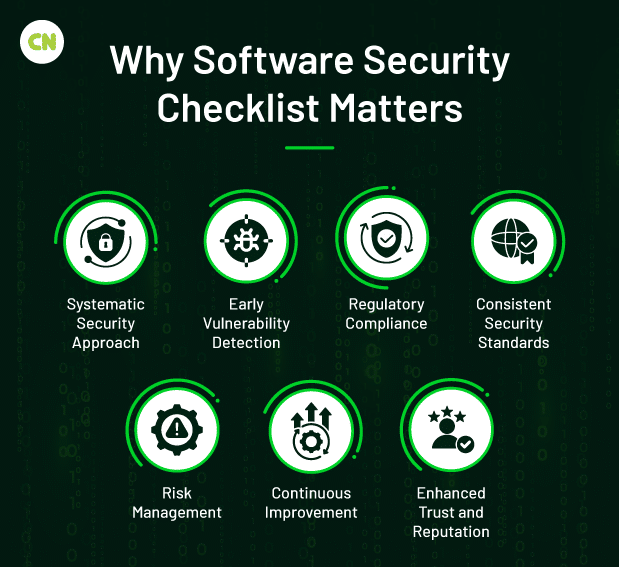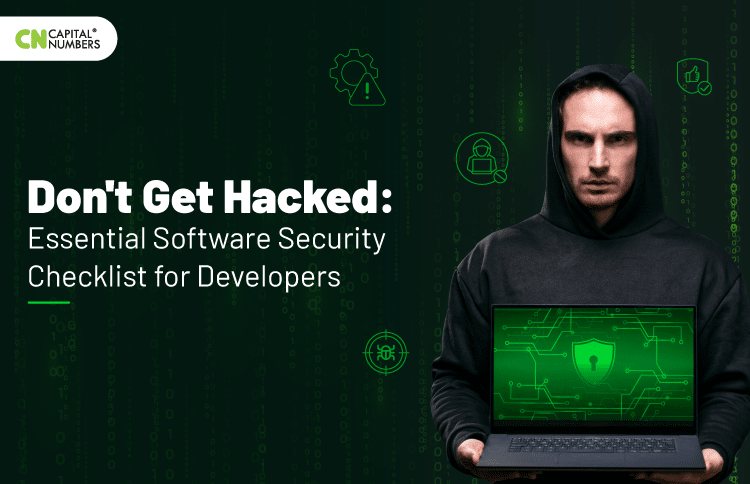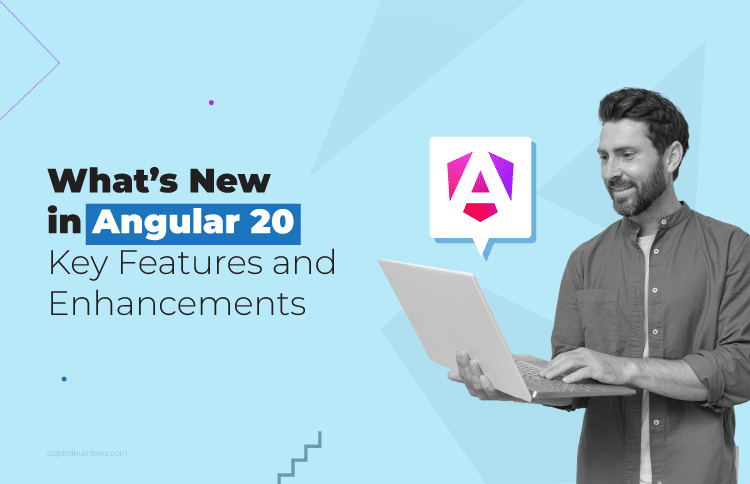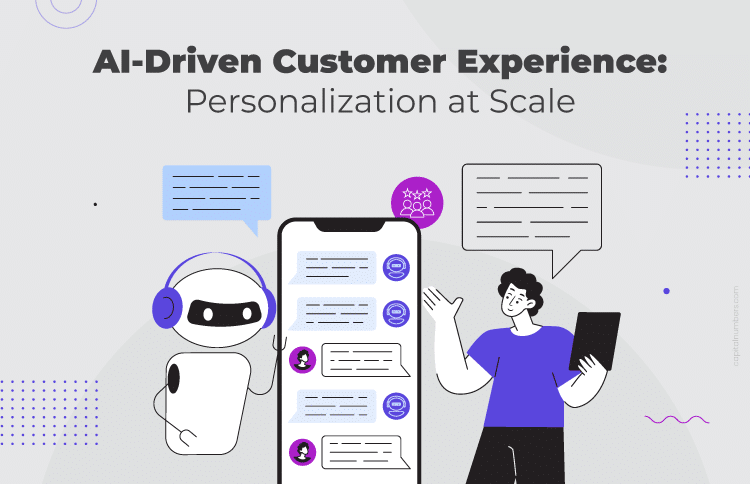Don’t Get Hacked: Essential Software Security Checklist for Developers
Table of Contents
In today’s digital world, cyberattacks are a constant threat. For developers, building secure software isn’t optional – it’s fundamental. A single software vulnerability can have devastating consequences, leading to exposing user data, disrupting operations, and damaging your reputation. What do you do to ensure secure software development?
We’ll provide a comprehensive checklist for software security best practices, covering everything from ensuring secure coding practices to securing APIs. By following these practices, you can reduce the risk of breaches and ensure your applications stand strong. So, take control of your software’s security and build with confidence – don’t get hacked!
Why Is Software Security Checklist Essential?

Implementing a software security checklist is crucial for organizations to protect their digital assets and ensure the integrity of their software solutions. Here are the key reasons why a software security checklist is vital:
- Systematic Security Approach: A checklist provides a structured framework for addressing security throughout the software development lifecycle (SDLC). It ensures no critical security measures are overlooked.
- Early Vulnerability Detection: It enables the early identification of potential security vulnerabilities and risks. This allows for timely mitigation before software deployment, reducing the likelihood of exploitation.
- Regulatory Compliance: Many industries are governed by strict data security and privacy regulations. A comprehensive security checklist helps ensure adherence to these regulations, avoiding potential fines and legal issues.
- Consistent Security Standards: A software security checklist ensures that security measures are uniformly applied across all organizational projects and teams. This fosters a consistent and high standard of security practices.
- Risk Management: By systematically addressing security concerns, a checklist helps manage effective risk. It prioritizes areas of high risk and efficiently allocates resources to address them.
- Continuous Improvement: Security checklists can be regularly updated and refined in response to emerging threats and new security insights. It contributes to a culture of constant improvement in security practices.
- Enhanced Trust and Reputation: Demonstrating a commitment to security through adopting a comprehensive security checklist can enhance trust among customers and stakeholders. This positively impacts an organization’s reputation.
Software Security Checklist for Developers
1 Code Upload Procedures
The code upload procedures encompass critical steps to safeguard and streamline development processes.
For SFTP/FTPS Uploads
- The setup on a Linux server involves configuring SFTP or FTPS protocols, which are essential for secure file transfers. This method prevents unauthorized access and data breaches by encrypting the data during transmission.
- Creating virtual user spaces for each project is another vital step, providing developers with a dedicated and secure workspace. This approach enhances security by isolating project environments and improving organization, making managing multiple projects easier.
- Integrating with a web server setup, such as Apache, Nginx, or Tomcat, provides developers a streamlined environment to deploy and test their web applications directly. This seamless integration is crucial for efficient development workflows as it facilitates immediate feedback and enables faster iteration cycles. By leveraging established web server technologies, developers can easily deploy and test their applications, leading to quicker development cycles and improved productivity. This integration also ensures compatibility with industry-standard server configurations, enhancing the scalability and reliability of web applications.
For GIT Uploads
- Ensuring project-specific private access to GIT repositories is fundamental to protecting the codebase. Limiting access to authorized team members prevents unauthorized viewing or alteration of the code, thereby safeguarding intellectual property and maintaining the project’s integrity.
- This controlled access also facilitates a secure collaboration environment, where developers can work together on code changes while ensuring that every contribution is tracked and managed properly. This is critical for maintaining code quality and facilitating effective team collaboration.
2 Code Scanning Practices
Code scanning practices are vital for ensuring the security and quality of software development projects. These practices include several key components:
Preventing Sensitive Data Exposure
- Using tools such as ‘.gitignore’, ‘git secrets’, and ‘trufflehog’ is crucial for safeguarding sensitive information like credentials and confidential data. ‘.gitignore’ helps exclude files from being committed to Git repositories, reducing the risk of accidentally pushing sensitive data. ‘git secrets’ scans for secrets being uploaded, and ‘trufflehog’ searches through git histories for high entropy strings and secrets, preventing potential data breaches.
- This practice is essential for maintaining the security integrity of codebases, ensuring that sensitive data is not exposed to unauthorized users or the public, thereby mitigating risks associated with data leaks and security vulnerabilities.
Docker Image Security
- Employing container scanning tools like ‘Trivy’ and ‘Snyk’ is imperative for identifying vulnerabilities within Docker images. These tools scan for known vulnerabilities within the container images and dependencies, offering insights and recommendations for remediation.
- Docker image security is a critical aspect of containerized application development, ensuring that the deployment environment is free from security flaws that attackers could exploit, thereby safeguarding the application infrastructure.
Code Quality Checks
- Using ‘Sonarqube’ for continuous inspection of code quality is a proactive approach to maintaining high standards in software development. Sonarqube evaluates code for potential bugs, code smells, and security vulnerabilities, besides assessing code coverage parameters to ensure thorough testing.
- Implementing code quality checks is crucial for the development lifecycle, enhancing the reliability and maintainability of the code. It helps developers identify and resolve issues early in development, leading to more secure, efficient, and high-quality software products.
3 Backend Infrastructure Security
Backend Infrastructure Security is a cornerstone in safeguarding web applications and services from cyber threats. Effective measures include
Enforcing HTTPS
- Transitioning from HTTP to HTTPS is fundamental for enhanced security. HTTPS encrypts data in transit, preventing interceptors from understanding the traffic between a client and server. This encryption is facilitated by SSL/TLS protocols, which not only protect the data integrity and privacy but also authenticate the visited website.
- Enforcing HTTPS is critical for all web services, as it ensures that sensitive information like login credentials, personal data, and transaction details are securely transmitted, thus safeguarding against eavesdropping and man-in-the-middle attacks.
Firewall Protection
- Implementing Web Application Firewalls (WAF) provides a protective barrier for web applications by filtering, monitoring, and blocking malicious HTTP/S traffic to and from a web service. WAFs are configured to protect against various web application vulnerabilities such as SQL injection, cross-site scripting (XSS), and other OWASP Top 10 threats.
- Firewall protection is vital for maintaining website security, protecting against targeted attacks that could compromise the application and data, thereby ensuring the integrity and availability of web services.
Secure Content Delivery
- Utilizing Content Delivery Networks (CDN) for caching enhances web service performance and security. CDNs distribute the service spatially relative to end-users, improving website load times and reducing bandwidth costs. Moreover, employing pre-signed URLs for static content on services like Amazon S3 adds an extra layer of security, ensuring that only authorized access to the content is allowed.
- Secure content delivery is essential for modern web applications, as it improves user experience through faster content loading times and adds security measures to protect static and dynamic content from unauthorized access and attacks.
High Availability
- Designing infrastructure with Load Balancers is key to ensuring service continuity and handling high traffic efficiently. Load balancers distribute incoming network traffic across multiple servers, preventing any single server from becoming a bottleneck, thus enhancing the availability and reliability of web services.
- High availability is critical to backend infrastructure, ensuring that web applications remain accessible even during high-traffic periods or when individual servers fail. This resilience is crucial for maintaining user trust and business continuity.
4 API Security
API security is a key component of software security, ensuring that interfaces exposed for application interactions are safeguarded against unauthorized access and attacks. Here’s a concise overview of securing APIs effectively:
API Authentication and Authorization
- Implement strong authentication mechanisms, such as OAuth2, to verify the identity of API users, ensuring that only authorized users can gain access.
- Enforce strict authorization controls to manage what actions authenticated users can perform, restricting access to sensitive operations and data within the API.
API Rate Limiting
- Implement rate limiting to safeguard against brute-force attacks and abuse. This involves restricting the number of requests a user can make to the API within a specific timeframe, preventing overload, and ensuring availability for all users.
API Monitoring
- Continuously monitor API activity to detect and respond to suspicious behavior. This involves tracking and analyzing API calls to identify anomalies that may indicate potential security threats or breaches, enabling timely intervention to mitigate risks.
5 Secure Deployment Strategies
These strategies are crucial for software’s reliable and safe delivery in today’s cloud-centric environment. Implementing these strategies ensures that applications are not only deployed efficiently but also maintained in a secure state against potential vulnerabilities and threats:
Kubernetes and Cloud Deployments
- Adopting GitOps for secure Continuous Integration/Continuous Deployment (CI/CD) processes represents a paradigm shift in managing deployments and infrastructure as code. GitOps leverages Git as a single source of truth for declarative infrastructure and applications, enabling automated, predictable, and more secure deployments. By integrating security checks and tests into the CI/CD pipelines, GitOps facilitates a more secure and streamlined deployment process, particularly in Kubernetes environments where configuration and infrastructure management are critical.
- This approach enhances the security posture by ensuring that any changes made are auditable, verifiable, and reversible, thereby minimizing the potential for human error and increasing the efficiency of deploying and managing cloud-native applications.
Cloud Security Measures
- Establishing specific security groups and Identity and Access Management (IAM) policies is foundational for cloud security measures. Security groups act as virtual firewalls, for instance, controlling inbound and outbound traffic and ensuring that only authorized access is permitted. Similarly, IAM policies provide granular permissions to users and services, ensuring that entities have only the access needed to perform their tasks, following the principle of least privilege.
- Using tools like ClamAV, Rootkit Hunter, and OpenVAS for vulnerability management plays a pivotal role in identifying and mitigating threats. These tools offer different capabilities, such as malware scanning with ClamAV, detecting rootkits with Rootkit Hunter, and comprehensive vulnerability assessments with OpenVAS, covering various system and network security aspects.
- Implementing these cloud security measures is essential for protecting infrastructure and data from unauthorized access, data breaches, and other cyber threats. By proactively managing vulnerabilities and enforcing strict access controls, organizations can significantly reduce their attack surface and enhance their overall security posture in the cloud.
6 Comprehensive Monitoring and Logging
Comprehensive monitoring and logging strategies are essential for maintaining the operational health and security posture. These strategies enable organizations to detect issues, analyze trends, and respond to incidents proactively.
Logging Mechanisms
- Implementing robust logging solutions such as Nagios, CloudWatch, Datadog, and the ELK stack (Elasticsearch, Logstash, and Kibana) is crucial for detailed monitoring and auditing. These tools provide real-time visibility into system and application performance, helping identify anomalies, performance bottlenecks, and potential security incidents. For example, Nagios offers extensive monitoring capabilities for network services, CloudWatch integrates deeply with AWS services for logs and metrics, Datadog excels in cloud-scale monitoring, and the ELK stack offers powerful log processing and visualization features.
- Effective logging mechanisms are foundational for understanding the state of the IT infrastructure, ensuring that performance issues and security threats can be identified and addressed promptly, thereby minimizing impact on operations and security.
Centralized Log Management
- Aggregating logs from various sources into a centralized management system is key for enhanced analysis and gaining deeper security insights. Centralized log management simplifies the collection, storage, and analysis process, making it easier to correlate events across different systems and applications. This comprehensive view aids in detecting complex security threats and operational issues that might not be apparent when viewing logs in isolation.
- Centralizing logs improves incident response times and supports compliance with regulatory requirements by ensuring that logs are accessible and auditable.
Access Management and Log Security
- Using AWS CloudTrail and configuring strict IAM policies are critical for securing log access and protecting sensitive data. CloudTrail provides a history of AWS API calls for an account, including actions taken through the AWS Management Console, AWS SDKs, and command-line tools, which is vital for security auditing. By configuring IAM policies, organizations can restrict log access to authorized personnel, reducing the risk of unauthorized log manipulation or access.
- Additionally, setting up S3 bucket logging with appropriate retention policies ensures that logs are not only securely stored but also retained for a period that complies with organizational and regulatory standards. This approach to log security and access management is crucial for maintaining the integrity and confidentiality of log data, providing a secure framework for logging activities across the cloud environment.
7 Data Protection
Data protection is critical to ensuring the confidentiality, integrity, and availability of data within an organization.
IAM Policies
- Configure strict IAM (Identity and Access Management) policies to control access to AWS resources. This includes limiting permissions for server admin accounts to prevent unauthorized access to sensitive data.
Encryption
- Enable encryption for sensitive data stored in S3 buckets to protect it from unauthorized access. This ensures that even if data is compromised, it remains encrypted and unreadable.
AWS CloudTrail
- Monitor all API calls made within the AWS environment using AWS CloudTrail. This allows for the tracking and auditing of user activity, providing visibility into who accessed what resources and when.
Network Security Controls
- Implement network security controls such as VPC (Virtual Private Cloud) security groups and NACLs (Network Access Control Lists) to restrict access to resources based on IP addresses, subnets, or ports.
Regular Security Audits
- Conduct regular security audits to assess the effectiveness of security measures, identify vulnerabilities, and ensure compliance with security best practices. This includes reviewing IAM policies, encryption settings, network configurations, and access controls.
8 Limit Access by Device
Access limitation enhances overall security by restricting server access to trusted devices, reducing the risk of unauthorized access and potential security breaches.
Network Access Controls
- Enforce strict network access controls using security groups or firewall rules to restrict server access based on trusted IP addresses or IP ranges. This prevents unauthorized access from unknown or suspicious devices.
Virtual Private Network (VPN)
- Implement a Virtual Private Network (VPN) to establish secure connections between devices and servers. Require device-level authentication before granting access to the server, ensuring that only authorized devices can establish connections.
Certificate-Based Authentication
- Leverage certificate-based authentication to enhance security further and verify the identity of devices connecting to the server. This involves issuing digital certificates to trusted devices, which are then used to authenticate and establish secure connections.
9 Threat Intelligence
Threat intelligence is important in strengthening an organization’s cybersecurity posture, such as cybersecurity for web applications or mobile apps. It involves leveraging advanced services and adopting stringent access control principles to detect, analyze, and respond to threats more effectively.
Integrating AWS Security Services
- Using a suite of Amazon Web Services (AWS) for comprehensive threat detection and response enhances an organization’s ability to identify and mitigate security threats. Amazon GuardDuty offers intelligent threat detection that monitors malicious activity and unauthorized behavior across AWS accounts. AWS Security Hub aggregates, organizes, and prioritizes security alerts or findings from multiple AWS services, providing a consolidated view of security posture.
- AWS Web Application Firewall (WAF) protects web applications from common web exploits that could affect application availability, compromise security, or consume excessive resources. AWS Shield provides managed Distributed Denial of Service (DDoS) protection, safeguarding applications running on AWS. Together, these services form a robust defense mechanism against various security threats, from potential data breaches to DDoS attacks, ensuring that resources are protected and resilient against attacks.
IAM for Least Privilege
- Employing the principle of least privilege through AWS Identity and Access Management (IAM) is fundamental to minimizing potential attack vectors. By granting only the necessary permissions required to perform a task, organizations can significantly reduce the risk of unauthorized access or escalation of privileges. AWS IAM enables fine-grained access control to AWS resources, allowing for the specific configuration of who can access what resources under which conditions.
- Monitoring activities with AWS CloudTrail further enhances security by providing a comprehensive log of all user activities and API usage across AWS infrastructure. This allows for detailed auditing, real-time security analysis, and the ability to respond to suspicious activities quickly. By employing least privilege and proactive monitoring, ensuring that access is strictly controbackuplled and that any deviations from expected behavior are quickly detected and remediated.
10 Backup
Backup is essential in any data management strategy, aiming to protect data from loss or corruption. It ensures data availability, even during system failures or cybersecurity breaches. This planning forms the backbone of organizational resilience, safeguarding critical data assets.
Database and Server Backups
- Implementing automated backup schedules through services like AWS Backup is essential for ensuring that data is regularly backed up without relying on manual intervention, thus reducing the risk of data loss. Automated backups can be configured to occur at regular intervals, capturing the state of databases and servers and storing this data securely in the cloud. This practice safeguards against accidental deletions, hardware failures, and data corruption and provides a foundation for disaster recovery efforts.
- Regular testing of backup integrity and restore processes is crucial to confirm that data can be effectively recovered after an incident. This involves periodically restoring data from backups to verify the data integrity and the effectiveness of the recovery process. Such tests ensure that backup systems are reliable and that recovery procedures are well-understood and documented, minimizing downtime in the event of an actual disaster.
11 Data Encryption Strategies
Implementing robust data encryption measures protects sensitive information stored within databases, safeguarding against unauthorized access and ensuring compliance with security standards.
Select Encryption Method
- Choose an appropriate encryption method, such as Transparent Data Encryption (TDE) or encryption-at-rest, based on database type and requirements.
Enable Encryption
- Use the database management console or API provided by the cloud provider to enable encryption for database instances or storage volumes.
Manage Encryption Keys
- Generate and securely manage encryption keys using a managed service like AWS Key Management Service (KMS) or by implementing customer-managed keys.
Configure Access Controls
- Set up proper access controls to restrict access to encryption keys, ensuring only authorized users can manage and access encrypted data.
Monitor Compliance
- Regularly monitor encryption status and key management processes to ensure compliance with security standards and mitigate potential security risks.
12 Security Testing
Security testing is critical to maintaining robust software security, identifying vulnerabilities, and ensuring that defenses are effective against potential attacks. Here’s a breakdown of essential security testing methodologies:
Penetration Testing
- Penetration testing, or pen testing, simulates cyber attacks against your software or network to check for exploitable vulnerabilities. It involves actively exploiting system weaknesses (e.g., unsanitized inputs and outdated software components) to assess the effectiveness of existing security measures. This proactive approach helps identify the real-world effectiveness of security controls and can provide valuable insights into how attackers could breach the system.
Static Analysis (SAST)
- Static Application Security Testing (SAST) analyzes source code or compiled code versions to find security flaws without running the program. SAST tools scan the code to identify potential security vulnerabilities such as SQL injection, cross-site scripting, and buffer overflows, making it possible to detect issues at an early stage in the development cycle. This method is beneficial for developers to integrate into the CI/CD pipeline for continuous security evaluation.
Dynamic Analysis (DAST)
- Dynamic Application Security Testing (DAST) assesses applications in their running state. It identifies vulnerabilities that appear during the execution of applications, providing an external viewpoint of security flaws. DAST tools simulate attacks on web applications to detect runtime issues like authentication and authorization flaws, session management issues, and more. This approach complements SAST by identifying only visible vulnerabilities when the application is running.
Security Scanning
- Security scanning involves using automated tools to scan for vulnerabilities within an application or network. These scans can be part of static and dynamic analyses, offering regular checks for common software security vulnerabilities, misconfigurations, and security weaknesses. Security scanners can be used to automate identifying potential vulnerabilities across the software development lifecycle (SDLC), ensuring continuous security monitoring and improvement.
Read More: Cybersecurity Best Practices for Fintech Software Development
Final Thoughts
Keeping software safe is a big deal in today’s world of cyber threats. For any software development company, following a security checklist is essential. By following this comprehensive software security checklist, you’ll be well-equipped to address critical security concerns throughout development. From secure coding practices to robust API security, this guide empowers you to develop reliable, scalable, resilient applications against cyber threats.
But keep in mind that security is an ongoing process. Regularly review and update your security practices to stay ahead of evolving threats. By adopting a culture of security awareness and implementing the strategies outlined here, you can reduce the risk of breaches and ensure the long-term success of your software.














